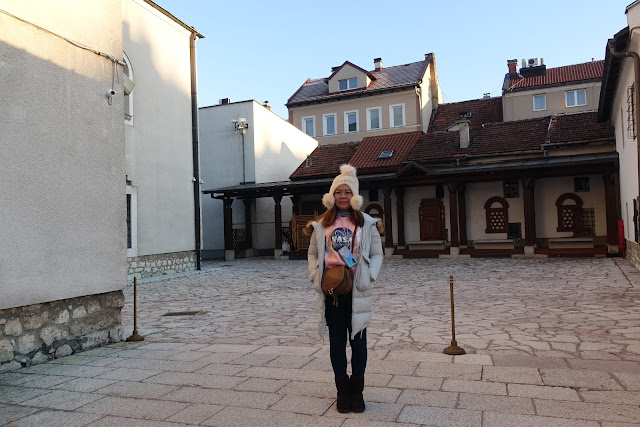Adventure to the Balkans Travelogue Pt. 2: Sarajevo, Bosnia
Thursday, April 30, 2020Today, we journey through the countryside of the Balkans to arrive at the second destination of the trip - Sarajevo in Bosnia. The population of Bosnia is 3 million with 70% Muslims, and the rest made up of Catholics and Christian Jews. It also has the nickname of being the Jerusalem of Europe. Sadly, their unemployment rate is 40%, as their country is still trying to recover from the civil war, which ended in 1994. For 4 centuries, they were occupied by the Ottoman Empire, which explains the Muslim architectural influences on their buildings. Later on, the Austro-Hungarian brought technology like the first tramway in Sarajevo. Come in and let's explore Sarajevo together!
Day 2: Zagreb, Croatia to Sarajevo, Bosnia
The mornings start as they all do - a delicious continental breakfast spread with a yummy selection of hams, cheeses and cured meat. Was groggy having to wake up quite early by 7am local time, as the bus usually departs at 9 am.
On the road to Bosnia, the second country on the itinerary. The weather was not really cold, wish it were colder so I could use my thicker sweaters... The farmers here in the countryside produce grapes, beer, cabbage and olives.
A pitstop to enjoy the mountainous scenery and greenery.
The Croats are fervent dog-lovers. We saw many dog owners on the streets, and many of them were pedigreed and very obedient! Couldn't resist snapping a few pics of them... Pictured here is probably a Spitz or a Pomeranian-mix dog.
Finally, we arrive in the quaint town of Sarajevo.
First, we were introduced to the "Spite House" across the river from where we were - The owner of the house refused riches and offers of larger, more elaborately built homes for his little house, where the government wanted to build a new city hall. His humble abode was thusly named "Spite House" for his stubbornness toward the authorities.
Behind me, you'll see a striped building, which is one of the city halls of Sarajevo. It was burned down in 1992 and then reconstructed. It used to contain many essential and historical books about the Balkans.
A closeup of the Sarajevo City Hall.
After being occupied by the Ottomans, Sarajevo was eventually conquered and became part of the Austro-Hungarian empire. The latter dynasty introduced many new technologies to the people of the city, including its first electrical tramway. The technology is still being used till today.
Now we come to one of the arguably most famous spots in Sarajevo - the Latin Bridge. This is was the site of the assassination of the Crown Prince of Austria which triggered WWI. He was due for a parade in Sarajevo to raise the morale of the people. However, his wife Duchess Sophia had a premonition of danger the night before and urged her husband to cancel the parade.
Unfortunately, just as her premonition warned her, a bomb that went off at the time of the parade. Their driver, who was Czech, has trouble understanding the Royal couple and turned in the wrong direction; the assassin was lying in ambush as their car (pictured above, a replica) drove past the Latin Bridge.
The Ottomans built a fortress protecting the East and Western points of the city. They are beautiful as you can see, sitting perched on top of high vantage points. However, they might be eventually destroyed to make way for modern developments in Sarajevo.
The next stop in our walking tour of Sarajevo - This is the first Mosque built in Sarajevo in the 15th century when the Ottoman Empire conquered the country. Many people of Sarajevo converted to Islam. Spurred on by their ardent faith, the Sultan of the empire built the Mosque as a gift to the converts. Sarajevo was then known as the Istanbul of the Balkans. By the 16th century, the city had developed to a point where they had a water plumbing; England only had their own indoor plumbing two centuries later.
A walk by the river in Sarajevo.
You would see many of these quaint cobblestone paths while exploring Europe.
Some ruins we chanced upon walking around the city.
One souvenir that you might want to purchase are these intricately-designed Turkish coffee cups.
The next path that we encountered were these beautiful limestone-paved roads.
Behind me, you will see the most giant clock tower in Sarajevo, using the Islamic calendar.
Beautiful Muslim-inspired architecture at the Emperor's Mosque.
Standing in front of a water fountain where Muslims would perform their ablutions before entering the Mosque.
Break for lunchtime!
Lunch was at Harizma, Doboj (Chicken and Pork).
A really really flavourful meal. The pork here is just much tastier than any I've tasted back home.
A little churro drizzled in honey for dessert!
Continuing onward to have more dessert. There are many many gelato shops in Croatia.
The blue-domed building you see in the background on the left-hand side is known as a Haman or bathhouse. In the past, the tanners of the city would be shunned by ordinary residents due to their smell after working in the leather tanneries, so the tanner established bathhouses where they could wash up. There are 7 Hamans or Bathhouses sprinkled around Sarajevo.
More delightful souvenir shops.
Slowly completing the Sarajevo Old Town tour and winding down for the day.
Dinner was a dish called Beef Sahan (Beef-stuffed Peppers) which is a local Bosnian dish.
That's all for the second part of the travelogue! Tuned in for the next part of the tour, which should be up by mid-week this week.
Sarajevo Bosnia Croatia itinerary travel travelogue Europe Balkans Latin bridge emperor's mosque Haman bathhouse Turkish coffee cup Turkish bathhouse gelato fun travelling solo travel EU travels Singapore review


















































0 commentors